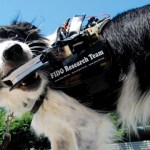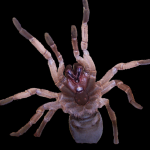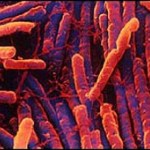Life Science
In honor of our most beloved Thanksgiving dinner guest:
Despite their rather large stature, ranging from 2.5-10.8 kg, wild turkeys (Meleagris gallopavo) can fly as seen in this video:
For more information about turkeys:
Cornell Lab of Ornithology
Researchers are studying tumors in the mammary glands of dogs to help understand breast cancer in humans with the goal of developing new treatments.
Follow On Twitter: @DrDoScienceBlog
Researchers in Romania have created a blood substitute with oxygen-carrying capacity using a protein called hemerythrin isolated from sea worms. This blood substitute has shown promise in studies of mice.
A new study from Science Translational Medicine (DOI:10.1126/scitranslmed.3006534) presents data showing that tauroursodeoxycholic acid (TUDCA), a compound isolated from the bile of bears, may actually slow the development of type 1 diabetes (in mice at least). It is thought to work by reducing stress responses from the endoplasmic reticulum in the insulin-producing beta cells of the pancreas which become defective in type 1 diabetes. Use of bear bile is common in traditional Chinese medicine, and at one time led to near-extinction of black bears in China. Fortunately, synthetic versions of…
Surgeons at Morriston Hospital in Swansea are using 3D printing technology to create titanium implants for a patient whose face was crushed in an accident. This was reported to be the first use of 3D printing to recreate a face after an injury.
Using CT scans, they created a mirror image of the side of the patient's face that was not damaged by the motorbike accident. They hope to begin the reconstruction process very soon.
This reconstruction project is actually the feature exhibit in "3D: Printing The Future" at the Science Museum in London until July 2014.
Source:
BBC News
For more…
In honor of Veteran's Day, we must not forget to thank the dolphins (and more recently sea lions) that have been active members of the US Military. The US military used dolphins trained to find and disarm underwater mines in the Iraq War. Eight dolphins served as the first marine mammals in active combat as part of the "Special Clearance Team One." The dolphins worked alongside drones equipped with sonar, Navy SEALS, reconnaissance swimmers from the Marine Corps, and divers trained to disarm explosives. When the drones detected something suspicious, the dolphins were able to discern whether…
I came across this interesting technology to communicate with dogs that I just had to share. A research team at Georgia Tech has come up with the idea of creating a high-tech vest for assistance dogs to better communicate with their owners. The project is called FIDO (Facilitating Interactions for Dogs with Occupations). The vests come equipped with sensors they are working on training dogs to activate through tugging, biting, and touching with their nose. Moreover, the vests can be equipped with technology enabling the dogs to alert doctors in the event of an emergency. Very cool!…
I am already starting to get excited about the 2014 Experimental Biology conference in San Diego next April. The program for comparative physiology is expected to be very good!
If you are a graduate student or postdoc submitting an abstract on comparative physiology for the meeting, don't forget to apply for the new Dr. Dolittle travel award. For more information, visit the Comparative and Evolutionary Physiology Section's webpage. All materials for the travel award including your abstract and blog are due by December 6th!
The panda bear cub recently born at the Smithsonian Zoo is approaching her 100th day of life. Following Chinese tradition, the zoo will be announcing her name on December 1st.
In the meantime, the zoo is asking for your help in choosing her name by casting your vote using the online poll that can be found here.
The finalists are:
Bao Bao (宝宝): Precious, treasure.
Ling Hua (玲花): Darling, delicate flower.
Long Yun (龙韵): Long is the Chinese symbol of the dragon; Yun means charming. Combined this represents a sign of luck for panda cooperation between China and the United States.
Mulan (木兰):…
Clip Art from www.LeeHanson.com
Just in time for Halloween:
Besides being an excellent way to avoid predators, roosting or hanging upside down is optimal for taking off into flight. Bats are not able to launch into flight from an upright position because their wings do not generate sufficient lift while at a dead stop. Additionally, their hindlegs are rather underdeveloped, so they are not able to run to generate lift for take-off. Instead, bats essentially fall into flight.
Learn more in this video comparing flight mechanics in bats and birds:
Source:
Animal Plant
FDA is looking for your help to determine source of illnesses and deaths related to dog jerky treats
Image from Vin News Service (http://news.vin.com/VINNews.aspx?articleId=22697)
The FDA is calling for help to determine the source of roughly 580 deaths and over 3600 illnesses (gastrointestinal and kidney) related to jerky treats that were made in China. The mystery dates back to 2007 when illnesses were first being reported by pet owners. Most of the victims have been dogs, although 10 cats have become sick from eating these treats as well.The FDA has tested treats for contaminants including chemical, microbiological/bacterial, antibiotics, metals, and pesticides in addition…
A recent article published in The Scientist about the use of robots to study animal behavior is a must-read! I had no idea this was such a seemingly common use of robots. Some researchers use them to mimic the movements of ants along paths of least resistance. While others have developed robots to study cockroaches, rodents, birds, squirrels, frogs, fish, bees, etc. Researchers study the robots in the lab or field to see how well they mimic the real thing or to understand how robotic animals and real animals interact. By studying robots, researchers often learn about the constraints an…
A guide from the Catalina Island Marine Institute discovered the carcass of an oarfish (Regalecus glesne) off the coast of Catalina Island this week. Oarfish are the longest bony fish (reports up to ~50 feet long) in the ocean. Because oarfish live deep in the ocean, there have been limited studies on their physiology or behavior. So this was quite the exciting find!
Other Sources:
LiveScience
Image from Reuters and The NY Times
Congratulations to Drs. Randy W. Schekman, Thomas C. Südhof and James E. Rothman (above left to right) for earning the 2013 Nobel Prize in Physiology or Medicine for their research in "discoveries of machinery regulating vesicle traffic, a major transport system in our cells."
Cells often make products like hormones and neurotransmitters that need to exit the cell in order to simulate or inhibit other cells. The reason these three scientists were selected for the award is that their research discovered how cells regulate the export of vesicles…
Photo credit: Margaret C. Hardy
Drs. Glenn King and Maggie Hardy at the Institute of Molecular Bioscience, University of Queensland, Australia have discovered a small protein, aptly named orally active insecticidal peptide-1 (OAIP-1), in the venom of Australian tarantulas (Selenotypus plumipes) that can kill prey when ingested orally. According to the study, OAIP-1 is fast acting and more potent than commercial pyrethroid insecticides and is very effective at killing the agricultural pest, cotton bollworm. The authors suggest that OAIP-1 may therefore be useful as a bioinsecticide.…
An article came out today in Wunderground.com about an iconic bird (in both good and bad ways) in South Africa, the Hadeda Ibis (Bostrychia hagedash). There are stores named after the birds, songs dedicated to them and even a documentary called "Hadeda Sunrise" that you can watch here:
Image from: www.beagleworld.net
I should have read this article before adopting my beloved pet, who is certainly not on the top 10 list of smart breeds.
A cute article from pet360.com published the top 10 smart breeds according to the American Kennel Club:
1. Border collie
2. German Shepherd
3. Bloodhound
4. Beagle
5. Labrador Retriever
6. Newfoundland
7. Belgian Malinois
8. Siberian Huskies
9. Golden Retriever
10. Australian Shepard
Did your dog make the top 10?
To find out what classifies these as the top 10 choices, see the article in Pet360.com
Image of C. difficile from BBC News.
You may recall a prior post about a dog that could smell when patients were infected with Clostridium difficile. C. difficile causes about 14,000 deaths per year in the United States. Recent breakthroughs in understanding gut microbes have led to the successful treatment of C. difficile in patients. Fecal transplants, the transfer of feces from a healthy person, has been life-saving for some patients for whom medical treatments are not effective or for recurrent infections. Listen to Billie's story here. To date, feces have been…
Dr. Janet Yamamoto from the University of Florida College of Veterinary Medicine was quoted in a press release this week saying, “One major reason why there has been no successful HIV vaccine to date is that we do not know which parts of HIV to combine to produce the most effective vaccine." Her research team is trying to develop a vaccine that stimulates T cells from people infected with HIV to respond to the feline (FIV) form of the virus. They are working toward that goal by searching for sections of the FIV virus that can activate T cells to attack HIV without mutating.
Dr…









